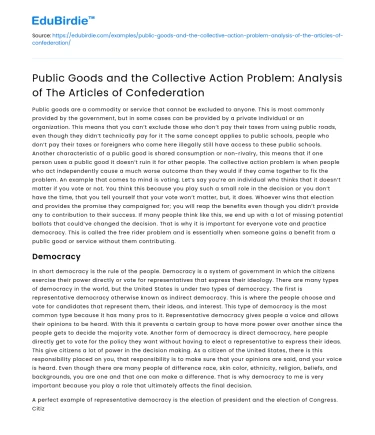Introduction
The Articles of Confederation, America's first constitution, served as a foundational document for the newly independent states. However, it was fraught with significant challenges, particularly regarding the provision of public goods and the management of collective action problems. Public goods, defined as non-excludable and non-rivalrous resources, were critical to the nascent nation. These included national defense, infrastructure, and legal frameworks. Yet, the Articles failed to empower the central government to effectively manage these resources. The collective action problem, where individuals or states act in their own self-interest contrary to the common good, further exacerbated these issues. This essay explores how the Articles of Confederation struggled to address public goods and collective action problems, contributing to its eventual replacement by the U.S. Constitution.
Public Goods Under the Articles of Confederation
The provision of public goods is a fundamental responsibility of any government. Under the Articles of Confederation, this provision was notably inadequate. The central government lacked the authority to levy taxes, relying instead on voluntary contributions from states. This led to a classic free-rider problem, where states benefited from public goods like national defense without adequately contributing to their costs. As noted by historian Gordon S. Wood, "the Confederation was a government of supplication, not coercion." This reliance on voluntary state contributions resulted in chronic underfunding of essential services. The inability to maintain a standing army left the nation vulnerable to external threats, as demonstrated by the British retention of forts in the Northwest Territory.
Save your time!
We can take care of your essay
- Proper editing and formatting
- Free revision, title page, and bibliography
- Flexible prices and money-back guarantee
Additionally, infrastructure projects, crucial for economic development, were neglected. The fragmented approach resulted in inconsistencies and inefficiencies. For example, interstate commerce was hindered by a lack of standardized systems, leading to economic discord. The absence of a central authority to coordinate such projects meant that states acted in isolation, often prioritizing local interests over national needs. This lack of cohesion underscored the limitations inherent in the Articles of Confederation regarding the provision of public goods.
The Collective Action Problem
The collective action problem under the Articles of Confederation was a significant impediment to effective governance. Collective action requires cooperation among states for the common good, yet the Articles fostered an environment where states prioritized their own interests. This was evident in the inability to regulate interstate commerce effectively. As each state imposed its own tariffs and trade restrictions, a fragmented economic system emerged, undermining the potential for a cohesive national market. Economist Mancur Olson’s theory of collective action highlights how individual incentives can lead to suboptimal outcomes for the group, a scenario that played out under the Articles.
Furthermore, the lack of a strong central government meant that policies requiring collective effort, such as defense and fiscal policy, were poorly implemented. The inability to compel states to contribute to a national treasury or adhere to treaties weakened the nation's international standing. The collective action problem was starkly illustrated during Shays' Rebellion, where the federal government's impotence in quelling the uprising demonstrated the need for a stronger, more cohesive national framework. This event was pivotal in highlighting the weaknesses of the Articles and the necessity for a more robust system of governance.
Counter-Arguments and Historical Context
Some scholars argue that the Articles of Confederation were a necessary transitional framework that respected the autonomy of states following independence from British rule. They suggest that the decentralized approach allowed for experimentation and adaptation. Historian Merrill Jensen contends that the Articles reflected the revolutionary ethos of the time, emphasizing liberty and limited central power. However, while the Articles may have embodied the revolutionary spirit, they failed to address the complexities of governing a diverse and expansive nation. The need for a balance between state autonomy and national cohesion ultimately led to the drafting of the U.S. Constitution, which sought to rectify these deficiencies.
Moreover, the weaknesses in addressing public goods and collective action under the Articles provided valuable lessons for future governance. The subsequent Constitution incorporated mechanisms to mitigate free-rider issues, like the power to tax and regulate commerce, and established a more centralized authority to manage national affairs. These changes were instrumental in providing the necessary public goods and ensuring collective action, reflecting an evolution in understanding the role of government in a federal system.
Conclusion
The Articles of Confederation's failure to effectively manage public goods and collective action problems underscores the challenges of a decentralized governmental framework. While the Articles were an essential step in America's journey towards unity, they revealed significant limitations in addressing the needs of a growing nation. The inability to compel states to contribute to national interests, coupled with a lack of centralized authority, resulted in a system that was ultimately unsustainable. The transition to the U.S. Constitution marked a pivotal moment in resolving these issues, providing a stronger foundation for governance. This historical evolution highlights the critical importance of balancing state and national interests to effectively manage public goods and facilitate collective action.






 Stuck on your essay?
Stuck on your essay?

